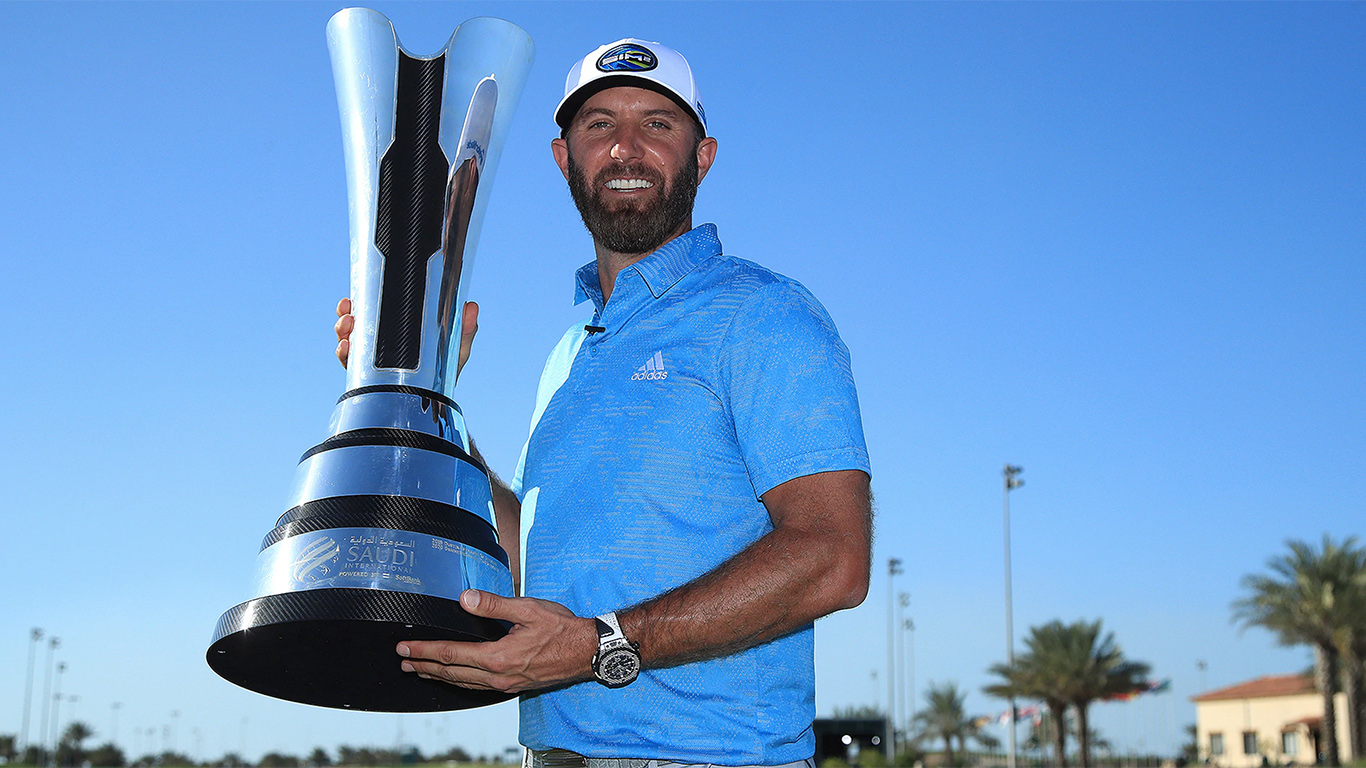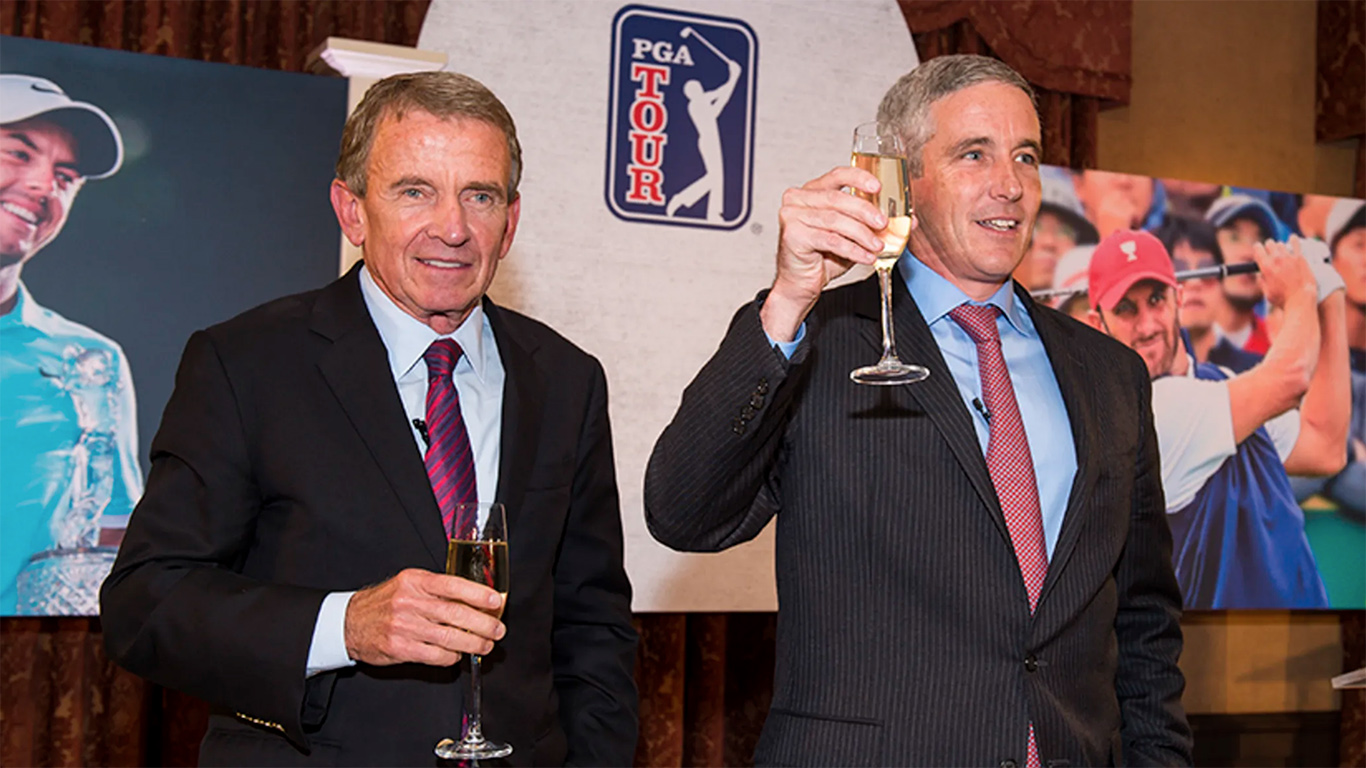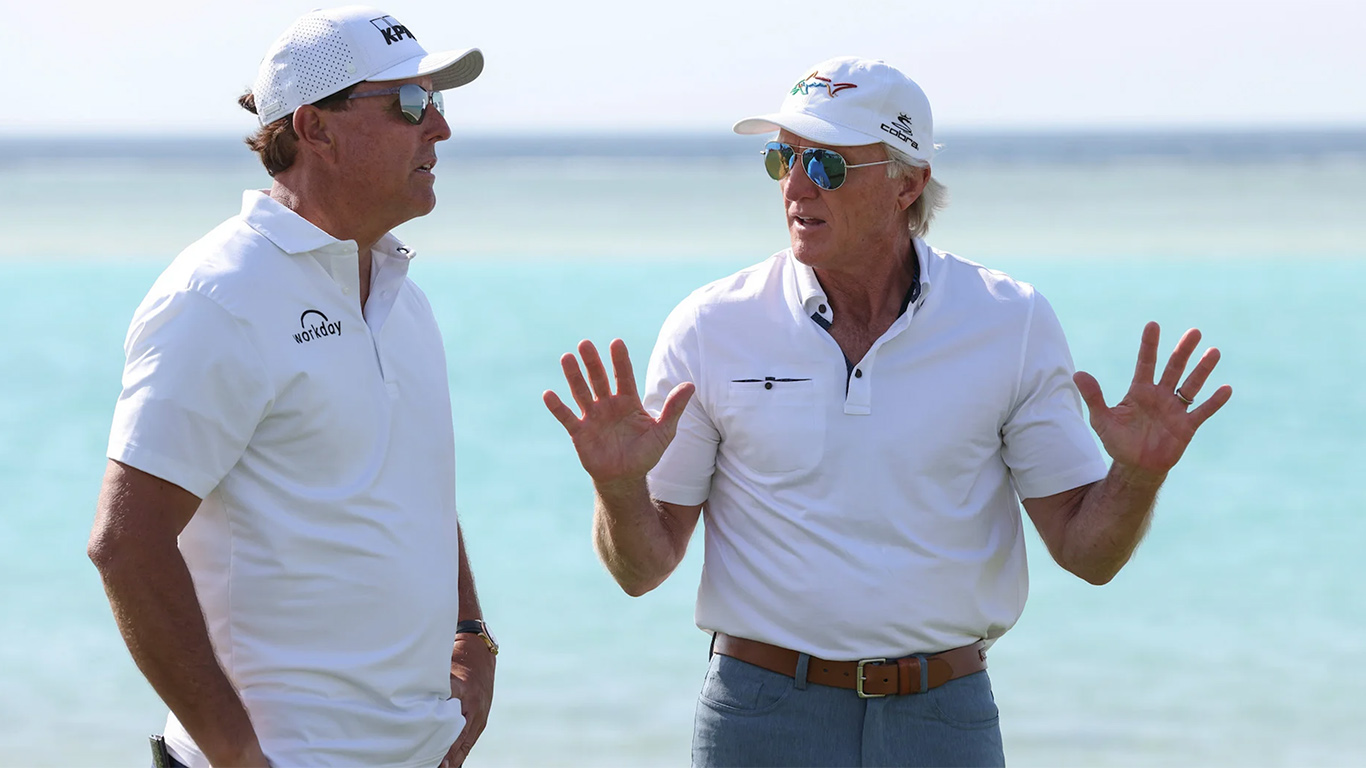Schadenfreude is not a virtuous emotion, but I wouldn’t blame you for feeling it toward Phil Mickelson over the past several days. Through his own arrogance and recklessness, Mickelson lost himself a great deal of money and accidentally sabotaged Saudi Arabia’s attempted takeover of professional golf. It would be Shakespearean if it weren’t so ridiculous.
Fans, journalists, and even PGA Tour pros joined the celebratory pile-on, and for good reason. Mickelson’s PR implosion had undermined a Saudi effort to sanitize its global image without correcting its human-rights abuses. The sooner the game can rid itself of this kind of sportswashing, the better.
But on Tuesday, as Mickelson finalized his defeat in an unconvincing apology, I began to see that he was making some decent points about the balance of power in the golf world. And I worried that, in our understandable eagerness to shun him, we would toss out the valid arguments with the venal ones.
◊
Let’s take a minute to review how we got here. Mickelson is—or perhaps was—deeply involved in plans to form a new “Super Golf League.” Backed by Saudi Arabia’s Public Investment Fund, the SGL hopes to buy off a few dozen of the best golfers on the planet and trot them out in a tournament series with a Formula 1-inspired team format. Mickelson was reportedly offered at least $100 million for his participation. Similar figures were likely dangled in front of Bryson DeChambeau and Dustin Johnson.
The SGL concept isn’t just a trial balloon launched by a few oil billionaires. It’s real, and it poses an existential threat to the PGA Tour.

Dustin Johnson lifts the Saudi International trophy in 2021 (Getty)
Then, last week, journalist Alan Shipnuck threw everything into chaos. In an excerpt from his forthcoming book Phil: The Rip-Roaring (and Unauthorized!) Biography of Golf’s Most Colorful Superstar, Shipnuck quoted Mickelson calling the Saudis “scary motherfuckers.” Mickelson elaborated: “We know they killed [Washington Post reporter and U.S. resident Jamal] Khashoggi and have a horrible record on human rights. They execute people over there for being gay. Knowing all of this, why would I even consider it? Because this is a once-in-a-lifetime opportunity to reshape how the PGA Tour operates.”
So, to paraphrase the poet Fred Durst, Mickelson did it all for the leverage. “As nice a guy as [PGA Tour commissioner Jay Monahan] comes across as,” he told Shipnuck, “unless you have leverage, he won’t do what’s right. And the Saudi money has finally given us that leverage.”
Since these comments landed, the public response has rightly focused on Mickelson’s moral failings. He knew the SGL was nothing more than a sportswashing ploy by an authoritarian regime, but he went along with it anyway. The backlash was immediate. DeChambeau and Johnson distanced themselves from the upstart league and clarified that, for now, they would stick with the PGA Tour. Mickelson’s sponsors began to scatter.
This fiasco was, by turns, hilarious, sad, and strangely satisfying to watch. But I don’t think it was an out-and-out victory. And that’s because Mickelson, despite being wrong on numerous matters both moral and factual, is right about one thing. The PGA Tour needs to be shaken up, and for that to happen, someone or something has to exercise leverage against it.
◊
The PGA Tour appears to me to have profound defects as an entertainment product. One is that the Tour makes it hard to keep track of storylines involving golf’s biggest stars. The 2021-22 schedule includes 43 tournaments, not counting the four major championships. Since top players like Rory McIlroy, Collin Morikawa, and Jon Rahm typically participate in 15 to 20 of these events, many fields have become diluted. This week’s Honda Classic, for instance, features none of the top 12 golfers in the world. The result is that following a PGA Tour season has become a disjointed experience, rarely offering coherent drama like, say, last year’s battle between Lewis Hamilton and Max Verstappen in Formula 1.
Another problem with the PGA Tour from a fan’s perspective is its general air of complacency. Most of the tournaments have the same format: 156 players, 72 holes of stroke play, and a cut after two rounds. With only a few exceptions, the golf courses are bland, set up more for inoffensiveness than challenge and variety. The telecasts, produced by NBC and CBS but driven by the Tour’s desires and commitments, are, to put it mildly, uncreative.
If you watch the PGA Tour every week, it’s probably because you really, really love golf.
Yet for the past two decades, tour leaders have appeared content with the status quo. Why wouldn’t they be? Since the late 1990s, when Tim Finchem thwarted Greg Norman’s world-tour plot and Tiger Woods became a global sensation, the PGA Tour has had no challengers to its supremacy in men’s professional golf. In 2020, commissioner Jay Monahan negotiated a media rights deal worth a reported $680 million. That’s the kind of money that justifies staying the course.

Jay Monahan celebrates his new job with former commissioner Tim Finchem in 2016 (PGA Tour)
But there’s another, perhaps more powerful reason that Monahan and others at the Ponte Vedra headquarters have shown little interest in innovation. The PGA Tour doesn’t serve the fans. Above all, it caters to its rank-and-file members, and those members don’t mind having 40-something tournaments per season (playing opportunities!), dull golf courses (predictable conditions!), and personality-free telecasts (minimal PR headaches!).
This state of affairs isn’t going to change on its own.
◊
To be clear, Phil Mickelson is the last player I’d pick to lead a professional-golf revolution. He has been dishonest in his dealings with the public and the media, and his willingness to align with Mohammed bin Salman should tell you everything you need to know about his scruples. But it’s worth making sense of the leverage he wants to use against the PGA Tour.
“The Tour only understands leverage,” Mickelson told John Huggan of Golf Digest on February 2. “And now the players are getting some of that. So things are changing and will continue to change. I just hope the leverage doesn’t go away. If it does, we’ll be back to the status quo.”
Although his motives are self-serving and his methods amoral, Mickelson is correct that the leverage created by the threat of a rival league has jolted the PGA Tour into action. Last year, the Tour established the Player Impact Program, which distributes $40 million to the 10 players who have had the largest impact through social media. The Players Championship purse has gotten a boost, as has the season-long FedEx Cup bonus pool. The Tour is even developing an NFT (Non-Fungible Token; don’t ask) platform as an additional source of revenue.
These efforts to funnel more money to players promise no particular benefits to fans. But on the entertainment side of things, whether motivated by the Saudi specter or not, the PGA Tour has shown signs of life recently. Its in-house content has improved and CBS coverage is rounding into form. Last month, the Tour confirmed that Netflix would create a Drive to Survive-style documentary series about the 2022 golf season and that 23 players had agreed to participate. This is a big step forward, given the Tour’s usual reluctance to give outside media access to events and players.
Equally heartening was last week’s news, drowned out by the Mickelson fracas, that the PGA Tour is considering an overhaul to its clunky wraparound schedule. As Rex Hoggard reported for Golf Channel, tour officials are developing a three-event series in the fall that would debut in 2023. The series would feature the top 50 players from the previous season’s FedEx Cup competing in a team format. It’s hard to imagine such an idea gaining traction in the pre-SGL era.

Phil Mickelson and LIV Golf Investments CEO Greg Norman discuss the lovely weather in Saudi Arabia (Getty)
The type of leverage at work here deserves further explanation. This is not generalized player power, where the wishes of journeymen and superstars carry roughly the same weight. Instead, the leverage generated by the SGL rests primarily with the golfers that the Saudis want to attract: the big names. And my belief is that if these marquee players had more sway in PGA Tour decision-making, fans would be better off.
Many of the Tour’s faults as an entertainment product stem from the organization’s responsibility to serve the majority of members. It’s this majority that pushes to maximize playing opportunities and causes the schedule to be bloated, unfocused, and full of large-field stroke-play events. A league structured around the interests of headliners would look different. It might even look something like the concept for the SGL (which, remember, the Saudis stole from the OG insurgent tour, the Premier Golf League): fewer players, fewer tournaments, a team format, and an opportunity for fans to follow consistent storylines around a manageable number of personalities.
But as long as the stars who sell TV-rights contracts have a similar amount of organizational influence as the guys who can walk into a Jupiter, Florida, tiki bar without being recognized, nothing like a super league can happen within the PGA Tour.
Two things can be true. One, the SGL should be scorned as a cynical attempt to launder Saudi Arabia’s international reputation through sports. Two, the PGA Tour’s best, most compelling players can and should pursue leverage—involving clean money—to change how professional golf is presented.
◊
For much of this month, and especially after Alan Shipnuck’s scoop, the mainstream golf media, normally a player-friendly bunch, has set Phil Mickelson ablaze. Much of the criticism has been rooted in a healthy refusal to normalize the Saudi incursion into the game. But lately I’ve noticed another set of talking points creeping into the anti-Phil discourse.
Take Golf Channel analyst Brandel Chamblee’s comments after Mickelson’s statement on Tuesday. Chamblee correctly pointed out the self-serving agenda behind the player’s words and defended Shipnuck against Mickelson’s charge of unethical reporting. He also referred to Saudi Arabia as “arguably the most reprehensible regime in the world.”
But the crux of Chamblee’s commentary was a full-throated defense of the PGA Tour and professional golf’s status quo. “How does [golf] desperately need change?” he said. “The game of golf is booming…. The PGA Tour is doing extraordinarily well.” He went on to describe the PGA Tour as “a very philanthropic tour that takes care of players from the time they get out of college until they want to hang it up.”
On the subject of the Tour’s generosity to players, Chamblee was particularly adamant: “I can’t imagine a tour that takes care of players from the beginning of their career until late into old age other than the PGA Tour; whereas the Saudi-backed tour is pretending they can just pick 30-40 players, statically, and that represents the best of the game. They have no feeder system for this tour and certainly when they start playing poorly, they will be gone.”
This wasn’t just a takedown of the SGL; it was a critique of any small, star-driven league that might compete with the PGA Tour.
Maybe I don’t need to explain that Chamblee’s employer, Golf Channel, has a close relationship with the Tour. Or that, as Brendan Quinn reported for The Athletic, the 2020 TV-rights deal forced Golf Channel to cut costs and become more intertwined than ever with the primary subject of its coverage. (“The PGA Tour had all of the leverage,” Quinn wrote about the rights negotiations.)
Ponte Vedra’s boosters in the media will no doubt continue to spin Phil Mickelson’s meltdown as proof that breakaway tours are bad news. But as for the rest of us, I hope we reject the Saudi pitch because it involves sportswashing, not because the PGA Tour should remain unchallenged.


 by
by 
